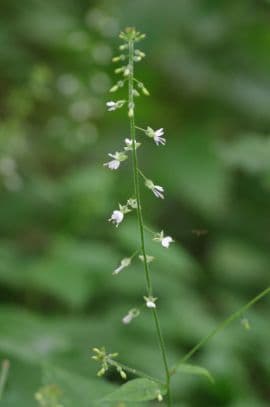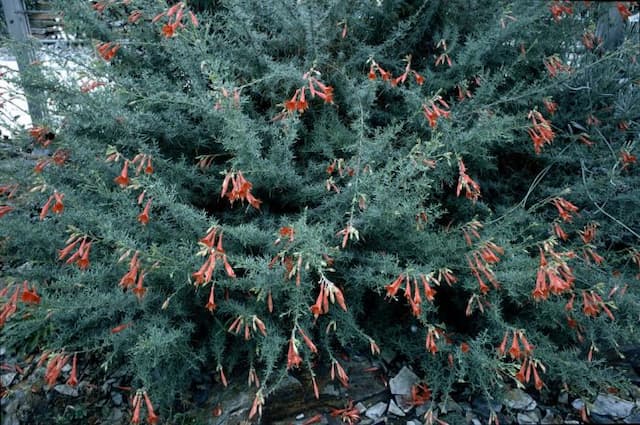White Gaura Oenothera lindheimeri Snow Fountain = 'Walsnofou' (G)

ABOUT
The Oenothera lindheimeri Snow Fountain, commonly known as White Gaura, is a flowering perennial plant that is noted for its delicate and graceful appearance. This plant produces slender, erect stems that bear a profusion of flower spikes. The blooms themselves are a pure white color and resemble small butterflies, with four petals each displaying a fluttering effect in the breeze. These flowers cluster together to form a fountain-like spray that provides a light, airy texture in the garden. The foliage of the White Gaura is lance-shaped and often has a hint of red or pink on the leaves, which further enhances the overall visual interest of the plant. The leaves are narrow and arranged alternately along the stems, with a tendency to be basal, meaning they concentrate at the lower part of the stems, leaving the upper sections mostly focused on showcasing the blooms. The White Gaura's blossoms tend to open in the evening and throughout the night, adding to its unique charm.
About this plant
 Names
NamesFamily
Onagraceae
Synonyms
White Gaura, Lindheimer's Beeblossom, White Butterfly Gaura, Snow Fountain Gaura
Common names
Oenothera lindheimeri Snow Fountain, Gaura lindheimeri 'Walsnofou'.
 Toxicity
ToxicityTo humans
Gaura, the common name for Oenothera lindheimeri Snow Fountain, is generally considered non-toxic to humans. There are no reported cases of poisoning or toxicity from ingesting parts of the gaura plant. Therefore, there are no known symptoms related to poisoning from this particular plant for humans.
To pets
Gaura is also not known to be toxic to pets. There is no evidence to suggest that ingestion of parts of the gaura plant by pets would lead to poisoning or adverse health effects. As such, there are no specific symptoms or consequences documented for pet poisoning from this plant.
 Characteristics
CharacteristicsLife cycle
Perennials
Foliage type
Deciduous
Color of leaves
Green
Flower color
White
Height
2 feet 4 inches [70 cm]
Spread
2 feet [60 cm]
Plant type
Herb
Hardiness zones
5
Native area
North America
Benefits
 General Benefits
General Benefits- Attracts pollinators – Oenothera lindheimeri 'Snow Fountain' is known to attract bees, butterflies, and other beneficial insects which are important for pollination.
- Low maintenance – This plant is praised for being drought tolerant and requires minimal care once established, making it ideal for gardeners who prefer low-maintenance landscapes.
- Aesthetic appeal – With its beautiful white blooms and silvery foliage, this plant adds a striking visual interest to gardens and landscapes.
- Heat and drought tolerance – It can thrive in hot conditions and withstand periods of low rainfall, which makes it suitable for challenging climates or water-wise gardening.
- Deer resistance – This species is generally not preferred by deer, which can be beneficial in areas where deer browsing is a common problem for gardeners.
- Long blooming period – Oenothera lindheimeri 'Snow Fountain' offers a long season of blooms, often from early summer until frost, providing consistent color in the garden.
- Uses in landscaping – Ideal for use in borders, rock gardens, and containers, as well as naturalized areas or as ground cover.
- Soil adaptability – This plant is adaptable to a range of soil conditions, although it prefers well-drained soils.
- Fast growth – It establishes and grows quickly, which can be particularly useful for new gardens or when filling in spaces.
- Native plant advantages – As a variety of a native species, it is well-adapted to local conditions and can be a good choice for sustainable and regionally appropriate landscaping.
 Medical Properties
Medical PropertiesThis plant is not used for medical purposes.
 Air-purifying Qualities
Air-purifying QualitiesThis plant is not specifically known for air purifying qualities.
 Other Uses
Other Uses- Gaura 'Whirling Butterflies' can be used in cut flower arrangements, providing a delicate, airy look due to its long stems and white blooms which can last several days in a vase.
- The plant can serve as an excellent cover for ground-nesting bees, offering protection and a nearby food source with its blossoms.
- In garden design, it can act as a "filler" in container plantings, complementing taller plants with its fine texture and movement.
- Its drought tolerance makes it a good candidate for xeriscaping, which reduces the need for supplemental water from irrigation.
- Gaura 'Whirling Butterflies' can be used in educational settings to demonstrate the process of pollination and the role of pollinators in the ecosystem.
- The plant's long blooming period makes it useful for providing consistent visual interest in a garden, particularly for community or public spaces.
- Because it's resilient and low maintenance, this plant is ideal for urban landscaping where care and resources may be limited.
- The white flowers can act as a natural reflector in moon gardens, designed to be enjoyed in the evening.
- The spindly shape and motion of the plant in the wind may be used in gardens to create an impression of spontaneity and wildness.
- Gaura 'Whirling Butterflies' can be planted as part of a butterfly garden, attracting various butterfly species which find its nectar attractive.
Interesting Facts
 Feng Shui
Feng ShuiThe White Gaura is not used in Feng Shui practice.
 Zodiac Sign Compitability
Zodiac Sign CompitabilityThe White Gaura is not used in astrology practice.
 Plant Symbolism
Plant Symbolism- Resilience and Survival: Known as "White Gaura," Oenothera lindheimeri Snow Fountain symbolizes the ability to thrive in challenging conditions, as it is a hardy plant that can tolerate drought and poor soil.
- Purity and Innocence: The "White Gaura's" pure white blossoms represent innocence and chastity, making it a symbol of new beginnings and virtuous love.
- Adaptability: As a plant that adapts to its environment, the White Gaura signifies flexibility and the capacity to flourish in various situations.
- Transformation: The transition from bud to bloom in the White Gaura suggests transformation and personal growth, making it emblematic of positive change.
 Water
WaterWhite Gaura (Oenothera lindheimeri 'Snow Fountain') should be watered deeply but infrequently to encourage a strong root system, roughly once per week or when the top inch of soil feels dry to the touch. Depending on the size of the plant and weather conditions, this usually amounts to around 1-1.5 gallons of water. Decrease watering in the winter months when the plant is dormant. Overwatering or poor drainage can lead to root rot, so ensure soil drainage is good.
 Light
LightWhite Gaura thrives in full sunlight, needing at least 6 hours of direct sunlight per day. An ideal spot for this plant would be in a south-facing garden or landscape where it can receive abundant sunshine throughout the day to promote vigorous growth and flowering.
 Temperature
TemperatureWhite Gaura is a heat-tolerant plant that can survive in temperatures as low as 10°F in the winter and flourish in high summer temperatures up to 90°F or above. The ideal temperature range for growing White Gaura is between 60°F and 80°F to ensure optimal growth and flowering.
 Pruning
PruningPruning White Gaura is beneficial to promote bushier growth and encourage more blooms. Prune in early spring by cutting back the plant to about one-third of its size to remove any dead or damaged stems. Additional light pruning can be done throughout the growing season to remove spent flowers and encourage continued blooming.
 Cleaning
CleaningAs needed
 Soil
SoilGaura, commonly known as Whirling Butterflies, thrives in a well-draining soil mix with a pH of 6.0 to 7.0. For optimal growth, prepare a mixture of loamy soil, peat, coarse sand, and perlite or pumice to ensure good drainage.
 Repotting
RepottingGaura, or Whirling Butterflies, typically doesn't require frequent repotting; it can be repotted every 2-3 years. The best time to repot is in the spring when active growth begins.
 Humidity & Misting
Humidity & MistingWhirling Butterflies prefer moderate humidity levels but are quite adaptable. They can thrive in the average humidity levels found in most outdoor garden environments.
 Suitable locations
Suitable locationsIndoor
Ensure bright light and good air circulation.
Outdoor
Full sun, well-drained soil, water sparingly.
Hardiness zone
5-9 USDA
 Life cycle
Life cycleOenothera lindheimeri 'Snow Fountain', commonly known as White Gaura, begins its life cycle as a seed that germinates in well-draining soil with full sun exposure. Upon sprouting, it develops a deep taproot and a basal rosette of leaves from which stems elongate. During spring and summer, elongated stems produce white, butterfly-like flowers that bloom in succession over a long period. After pollination by insects, the flowers develop into small, dry fruits containing seeds. As a perennial plant, the above-ground foliage dies back in the fall or winter, while the root system remains alive to support new growth the following season. Throughout its lifecycle, White Gaura may also spread through root division, allowing the plant to form larger clumps or colonies.
 Propogation
PropogationPropogation time
Spring to early summer
Oenothera lindheimeri Snow Fountain, commonly known as White Gaura, is most effectively propagated through stem cuttings. This method offers a comparatively quick way to produce new plants that are true to the parent. To propagate by cuttings, gardeners typically take 3- to 5-inch long (about 7.5 to 12.5 cm) pieces of stem from the White Gaura in late spring or early summer. These cuttings are taken just below a leaf node, where the concentration of growth hormones is highest, and then the lower leaves are removed. The cut end is often dipped in rooting hormone powder to encourage root growth and planted in a well-draining soil mix. Keeping the soil consistently moist and providing a warm environment with indirect light will help the cuttings take root within a few weeks. Once established, the rooted cuttings can be transplanted to their final growing location.









